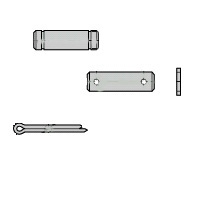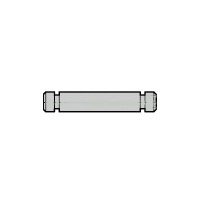(!)NOTE : Windows 7 users won’t be able to use some latest features of eCatalog/WOS since Microsoft is ending support for Windows 7 on 14 Jan, 2020. Please upgrade your system for uninterrupted services.
- Notice of End of Sales for Economy Series Pneumatic Equipment Category. More information.
Knuckle Joints(Type:Accessories)
|
Type
|
|
|---|---|
Brand |
|
| CAD |
|
| Days to Ship |
|
3 items
- Sort By
-
You can add up to 6 items per a category to the compare list.

Double Knuckle Joint Pin for CMK2, CMA2, CKV2, JSK2, JSM2 Brackets
CKD
Double notched knuckle for SSD. Pin (including ring) is attached.
Mounting Method Thread Size M(mm) Type Thread Pitch(mm) Material Accessories Included - - Accessories - Steel Included From: ₹ 472.94 Days to Ship: 5 Day(s) or more  5 Day(s) or more
5 Day(s) or more
-
You can add up to 6 items per a category to the compare list.

Brackets for SSD2, Pin for Double Notched Knuckle Joint
CKD
Double notched knuckle pin for SSD2.
Mounting Method Thread Size M(mm) Type Thread Pitch(mm) Material Accessories Included - - Accessories - - Not Included From: ₹ 418.24 Days to Ship: 5 Day(s) or more  5 Day(s) or more
5 Day(s) or more
-
You can add up to 6 items per a category to the compare list.

SSD/USSD Fitting, Pin for Double Notched Knuckle Joint
CKD
Double notched knuckle joint pin for cylinder SSD, USSD.
Mounting Method Thread Size M(mm) Type Thread Pitch(mm) Material Accessories Included - - Accessories - - Not Included From: ₹ 1,173.99 Days to Ship: 5 Day(s) or more  5 Day(s) or more
5 Day(s) or more
| Brand |
|---|
| Product Series |
| From |
| Days to Ship |
| Mounting Method |
| Thread Size M(mm) |
| Type |
| Thread Pitch(mm) |
| Material |
| Accessories Included |
You can add up to 6 items per a category to the compare list. | You can add up to 6 items per a category to the compare list. | You can add up to 6 items per a category to the compare list. | |
| Brand | CKD | CKD | CKD |
| Product Series | Double Knuckle Joint Pin for CMK2, CMA2, CKV2, JSK2, JSM2 Brackets | ||
| From | ₹ 472.94 | ₹ 418.24 | ₹ 1,173.99 |
| Days to Ship | 5 Day(s) or more | 5 Day(s) or more | 5 Day(s) or more |
| Mounting Method | - | - | - |
| Thread Size M(mm) | - | - | - |
| Type | Accessories | Accessories | Accessories |
| Thread Pitch(mm) | - | - | - |
| Material | Steel | - | - |
| Accessories Included | Included | Not Included | Not Included |
Loading...
Configure
Related Categories to Knuckle Joints
FAQ Knuckle Joints
- Question: In what applications are knuckle joints typically used?
- Answer: knuckle joints are commonly utilized in mechanisms requiring controlled rotational movement. They find applications in steering systems for automobiles and aircraft, allowing for precise direction control. In industrial machinery, such as cranes and robotic arms, knuckle joints facilitate movement in specific directions, enhancing versatility. Moreover, they play a vital role in construction equipment like excavators and loaders, ensuring efficient operation. Additionally, knuckle joints feature prominently in material handling systems and medical devices, providing flexibility and controlled articulation for various functions in engineering work.
- Question: What materials are commonly used for knuckle joints?
- Answer: Knuckle joints, vital for controlled rotational movement, utilize diverse materials based on specific needs. Steel, including carbon, alloy, and stainless variants, offers durability and corrosion resistance, fitting for industrial applications. Aluminum alloys balance strength and lightness, favored in aerospace and automotive sectors. Brass and bronze, prized for corrosion resistance and malleability, find use in architectural and heavy-duty contexts. Titanium's exceptional strength-to-weight ratio and corrosion resistance suit aerospace and high-performance machinery. Material selection hinges on factors like strength, weight, corrosion resistance, and environmental conditions, ensuring optimal functionality in diverse applications.
- Question: How do you maintain a knuckle joint?
- Answer: Maintaining a knuckle joint involves routine checks and actions to ensure its smooth operation and longevity. First, inspect the joint regularly for wear, damage, or misalignment. Clean the joint to remove dirt and debris that can cause friction and premature wear. Apply lubrication as recommended by the manufacturer to reduce friction and prevent corrosion. Tighten any loose fasteners to maintain structural integrity. Replace worn or damaged components promptly to prevent further issues. Finally, conduct operational tests to verify proper functionality. By following these steps, you can ensure the knuckle joint operates effectively and safely, extending its service life and minimizing downtime.
- Question: How do you determine the correct size of a knuckle joint for a specific application?
- Answer: Determining the correct size of a knuckle joint involves a comprehensive assessment of various factors. This includes analyzing the application's load requirements (static and dynamic), considering the necessary range of motion, evaluating environmental conditions, accommodating space limitations, and addressing mounting considerations. applications on industry standards, guidelines, and possibly consultations with experts to ensure the selected size can effectively withstand expected loads and movements while fitting seamlessly into the application's requirements.
- Question: Are there any limitations to using knuckle joints?
- Answer: Knuckle joints have limitations, including wear and fatigue over time, particularly under high loads or harsh conditions. They may introduce backlash or play, impacting precision, and improper maintenance or lubrication can hasten wear. The designer must carefully consider these factors when integrating knuckle joints into designs, ensuring optimal performance and longevity.












How can we improve?
How can we improve?
Thank you for your time.
Your feedback is essential for our continuous improvement
Privacy Policy
Thank you for your cooperation.
Thank you for your time.
Your feedback is essential for our continuous improvement
Please use the inquiry form.
Privacy Policy